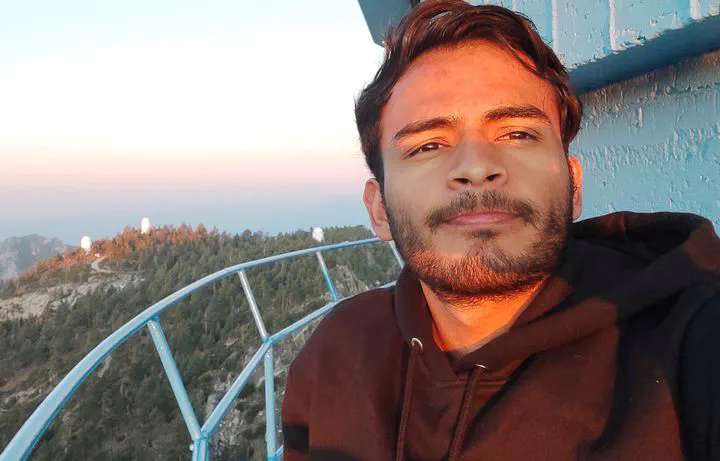My journey
 My first trip to OAN-SPM
My first trip to OAN-SPMMy career in brief
I was born in Chaparral, a municipality in the department of Tolima (Colombia), at the foot of the Central Andes mountain range. I lived almost all my life in the El Rocío neighborhood, where I also studied up to third grade.
After living in Bogotá for a couple of months, I returned to the rural area of Chaparral to finish elementary school in the village of Chontaduro, in the Calarma region. I was promoted from third to fifth grade only because there was no certainty that the following year there would be a teacher in the school, since there were only six students in total.
After finishing elementary school, I studied sixth and seventh grades at the Manuel Murillo Toro School, in the urban area of the municipality.
When I finished seventh grade, I moved back to Bogotá to finish high school at the Fabio Lozano Simonelli (Falosi) school, in the La Fiscala neighborhood of Usme. Before that, I had studied for a year at the Arnulfo Briceño Contreras school in Villavicencio.
It was at Falosi that I first learned about astronomy, thanks to a short course for teachers that I took at the Planetarium of Bogotá. Until then, although I had never been a bad student, I had not stood out for my academic results either. My grades were not bad, but not the best either. I think it was because nothing had completely caught my attention or I enjoyed it in any special way.
After taking the planetarium course, I got fully involved in the school astronomy club and, soon after, I knew I wanted to dedicate myself to astronomy. I participated in the Colombian Astronomy and Astrophysics Olympics and, although I only made it to the second qualifying round, that experience helped me to learn on my own and confirm that I really enjoyed astronomy.
I graduated as a high school graduate in November 2018 and, thanks to the help of the Higher Education for All Fund (FEST) of the District Education Secretariat (SED), I was able to finance my Bachelor’s degree in Natural Sciences at the University of La Sabana.
There I was trained as a natural sciences teacher with an emphasis on physics, in the Faculty of Education. Although most of my studies were focused on teaching natural sciences, I never left astronomy aside.
I participated in a research group in astronomy teaching with which we carried out many activities in science education and astronomy outreach in the province of Sabana Centro, the region of greatest influence of the La Sabana.
During undergrad, I also learned more about astronomy and the skills I would need to be accepted into a graduate program. Around those years I learned about the field of exoplanets, because my closest mentors work in astrobiology and planetary sciences. I learned about what they are, how they are detected, how they are studied, and what are some of the questions that are still unanswered.
By the time I finished my degree, it was clear to me that I wanted to be an astronomer and dedicate myself to the study of exoplanets.
Thanks to two summer schools that I discovered by chance in Facebook astronomy groups, I got to know the Instituto de Astronomía of the Universidad Nacional Autónoma de México (UNAM). After applying twice to the School of Observational Astronomy for Latin American Students (ESAOBELA), I was accepted and had the opportunity to travel to Mexico for the first time in 2023.
During the ESAOBELA, I learned about the graduate program in astrophysics offered by UNAM and about the National Graduate Scholarship program offered by the Secretariat of Science, Humanities, Technology and Innovation (SECIHTI, formerly CONACYT), which is open to foreign students.
Then I decided that it would be the Instituto de Astronomía of UNAM, where I wanted to do my master’s degree in astrophysics and because I could apply with a degree in science education. I just had to pass the admission process.
And so it was, when I finished my Bachelor’s degree in Natural Sciences, while I was waiting for my degree and doing an internship to forgive my educational credit, I enrolled in the admission process for the Master’s degree and took the propaedeutic courses (virtually) to be accepted.
Going through the admission process was quite an experience that I hope to recount in detail in a separate blog post. After two months, I was admitted to the Master’s program at the Instituto de Astronomía UNAM with a full scholarship for the two years of the program.
When I received the notification of admission, I immediately contacted people I had already identified who work in the field of exoplanets. After several emails and a virtual meeting, Dr. Yilen Gómez Maqueo Chew, a researcher at the Instituto de Astronomía, accepted me to work in her group.
I am currently living in Mexico City, where I am in my third semester of my master’s degree in Astrophysics at the Ciudad Universitaria headquarters of the Instituto de Astronomía UNAM working on the analysis of light curves of transiting exoplanets.